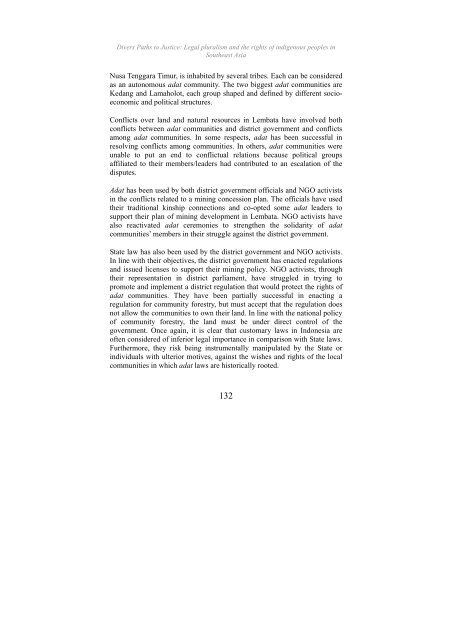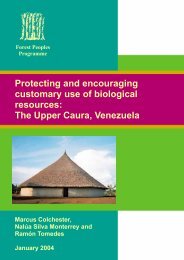Divers Paths to Justice - English - Forest Peoples Programme
Divers Paths to Justice - English - Forest Peoples Programme
Divers Paths to Justice - English - Forest Peoples Programme
Create successful ePaper yourself
Turn your PDF publications into a flip-book with our unique Google optimized e-Paper software.
<strong>Divers</strong> <strong>Paths</strong> <strong>to</strong> <strong>Justice</strong>: Legal pluralism and the rights of indigenous peoples inSoutheast AsiaNusa Tenggara Timur, is inhabited by several tribes. Each can be consideredas an au<strong>to</strong>nomous adat community. The two biggest adat communities areKedang and Lamaholot, each group shaped and defined by different socioeconomicand political structures.Conflicts over land and natural resources in Lembata have involved bothconflicts between adat communities and district government and conflictsamong adat communities. In some respects, adat has been successful inresolving conflicts among communities. In others, adat communities wereunable <strong>to</strong> put an end <strong>to</strong> conflictual relations because political groupsaffiliated <strong>to</strong> their members/leaders had contributed <strong>to</strong> an escalation of thedisputes.Adat has been used by both district government officials and NGO activistsin the conflicts related <strong>to</strong> a mining concession plan. The officials have usedtheir traditional kinship connections and co-opted some adat leaders <strong>to</strong>support their plan of mining development in Lembata. NGO activists havealso reactivated adat ceremonies <strong>to</strong> strengthen the solidarity of adatcommunities’ members in their struggle against the district government.State law has also been used by the district government and NGO activists.In line with their objectives, the district government has enacted regulationsand issued licenses <strong>to</strong> support their mining policy. NGO activists, throughtheir representation in district parliament, have struggled in trying <strong>to</strong>promote and implement a district regulation that would protect the rights ofadat communities. They have been partially successful in enacting aregulation for community forestry, but must accept that the regulation doesnot allow the communities <strong>to</strong> own their land. In line with the national policyof community forestry, the land must be under direct control of thegovernment. Once again, it is clear that cus<strong>to</strong>mary laws in Indonesia areoften considered of inferior legal importance in comparison with State laws.Furthermore, they risk being instrumentally manipulated by the State orindividuals with ulterior motives, against the wishes and rights of the localcommunities in which adat laws are his<strong>to</strong>rically rooted.132
















